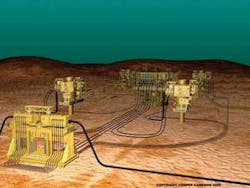SUBSEA/SURFACE SYSTEMS
Ted Moon, Houston
Subsea standardization welcomed by the industry
In what BP Subsea Engineer Chris Lindsey-Curran calls “really good news for the subsea industry,” the SIIS (Subsea Instrumentation Interface Standardization) joint industry project has reached early agreement on a protocol designed to standardize the interfaces deployed in the subsea industry.
A JIP set up by independent technology consultants OTM, SIIS has yielded early success resulting from cooperation and discussion between members of the oil and gas subsea industry worldwide.
The concept of SIIS originated with BP and Shell in 2003. In 2004, a Subsea Control System User Group was formed, involving oil and gas operators with representation from BP, Shell, Total, ENI-AGIP, Hydro, Statoil, and ChevronTexaco, as well as subsea control system vendors ABB Offshore System Ltd. (now Vetco Gray), Aker Kvaerner, Cameron, Dril-Quip, and FMC/KOS.
The first topic discussed by the Subsea Control System User Group was SIIS, with its aim to identify one of the existing protocols as basis for standard.
OTM’s Annie Hairsine is the network manager, providing project management to SIIS. She is pleased that agreement on the protocol has been reached so soon, particularly since SIIS was set up only two years ago.
Hairsine says, “SIIS focused on the interface between subsea sensors and the subsea control module. The group considered the interfaces required by all types of sensors in the subsea environment, and we consulted with the sensor vendors.”
In what is seen as further good news for the industry, the SIIS protocol settled on the Canbus CANopen interface type. CANopen is a network technology optimized for usage in industrial control environments. It is a ubiquitous and robust technology that is already used in many low-cost and medium-performance components in a variety of industries, making it well-suited for applications in subsea environments.
Lindsey-Curran says, “The upstream sector once again finds itself in a period of high demand, with the service sector and operators all struggling for resources, both human and physical.
“The oil industry is also striving to improve the performance of subsea systems through improvements in reliability. Historically, the service and operator companies have been free to choose interfaces as there were no standards for subsea. This led to a plethora of communication protocols being adopted across the industry when interfacing to third-party, external sensors.”
Service companies and sensor suppliers can now focus their energy on improving the key elements of their products to provide better service instead of focusing time on designing new interfaces.
“In SIIS meetings we have heard repeatedly with respect to protocols that no one cares what the standard is, but please pick one,” says Lindsey-Curran. “And now we have.”
OTM says oil and gas operators will be able to save time in not having to select a protocol, but being able to quote SIIS as the standard. Sensor companies will no longer have to develop, qualify, and test different interfaces to their sensors, which will save on engineering, manufacturing, and inventory. Standardization is also seen as good news for sensor suppliers, as they are now free to focus on sensor development and not have to consider a myriad of interfaces.
Subsea UK members get a business boost in Galveston
Several British companies serving the subsea market traveled to Galveston, Texas, in March for the industry-leading annual event, the Subsea Tieback Forum (SSTB). As a direct result of exhibiting, the companies have reported the potential for several million dollars worth of new business.
Subsea UK, the industry body which champions the UK’s subsea expertise and experience, led the initiative to get these companies involved in SSTB, and organized a major exhibition area at the event.
A total of 14 UK companies made the trip, and six quickly reported new business -- Bibby Offshore, Rotech Subsea Ltd., DES Operations, Imes Group, Circle Technical Services, and Litre Meter.
Litre Meter, a specialist in the design and manufacture of chemical injection flow meters, picked up a number of leads at its exhibit booth. Matthew Armstrong, sales and marketing director, said “We picked up seven quality leads, two of which led to requests for quotes. Those quotes are now in and we are in serious negotiations for one which entails a contract worth $349,000. This is very significant for a small specialist company such as ours.”
Kenneth Mackie, director of Rotech Subsea Ltd., believes this event is one of the most successful for his company’s overseas promotion as it is focused on the sector. “This is the best event we have attended in years. We are still trying to evaluate all the valuable enquiries and potential projects that will be secured as a result of our participation in the event, but suffice to say there will be many. In terms of cost vs. opportunity, this has been a very worthwhile investment for us.”
Andrew Duncan, subsea business manager of Bibby Offshore, says, “The high level of interest in our services and the quality of contacts made have been very useful. This is the best exhibition we have participated in to date and could prove invaluable to us in pursuing international opportunities to expand our business.”
Subsea UK CEO David Pridden says the event helped the 120-member strong organization fulfill its objective of maximizing the British subsea industry’s opportunities globally.
Pridden says, “One of our key priorities is to promote UK expertise and experience abroad. Under the banner of Subsea UK, companies can collaborate effectively to present a unified and robust approach to overseas marketing. We have developed a program of international events which target key geographical areas such as West Africa, Southeast Asia, and the GoM, and will continue to build on this in 2006 and 2007.”
Most of the companies attending this year’s SSTB have already signed up for next year’s event.

